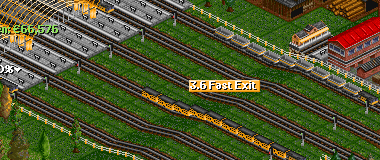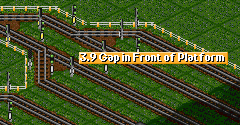Tutorial Savegame Stations
From #openttdcoop wiki
| << 2.x Sideline | Tutorial Savegame Stations | 4.x Feeder >> |
3.0 Stations
In this section one will find the most common techniques and tricks needed in order to construct some decent stations for our network.
3.1 Leave Waiting Space
A simple yet very important rule: leave a gap in front of a station to provide some waiting space if required. Depending on the output of the industry connected via the station you scale the amount of platforms (see 3.4) - scale the length of the waiting space as well! One of the worst things that could happen is an overflow of waiting trains at a station which queue back to a Sideline, therefore blocking it. If the sideline is popular enough, the backup can extend to the mainline, causing a major network jam.
3.2 One-direction only needed
One of the big advantages of the sideline concept: Sidelines-to-Station switches are very simple because its clear that only one direction is needed both for exit and entry.
3.3 Waiting Space for at least one Train
This is another example for the basic idea of 3.1: trains must never ever overflow in front of a station, therefore blocking it. If you have are really short on space for a long entry you can add some more station platforms to assure a train may always enter it.
3.4 Scale Station to Production
Correlated with 3.1 and 3.3: the more output expected, the more platforms needed at a station.
3.5 Avoid joining different Goods in one Station
There is one very good argument: imagine you have a forest with a high production and a coal mine with a very small production. Furthermore, imagine the forest drops dramatically and the coal mine rises dramatically: wood trains may now block the whole station. It's a problem especially on very large maps because on maps like 1024x1024 you should keep the need for train management low - in one of #openttdcoop's largest games, Pile Transport (> 1000 trains), the train management was a lot of dull work due to the fact that many stations were built inappropriately.
3.6 Fast Exit
Ensure that a train leaves a station platform completely until it may get a red signal. This will lower the chances for platforms of being blocked by a slow or jamming exit therefore rising the efficiency of each platform.
3.7 Fake Station
A so called "fake station" may be considered as a cheat and therefore not used too often. In some situation its just a simple and non-hurting chance to ensure your drop station to accept a certain type of good. Also, it helps you to bundle several industries of the same type within a small area—such as a couple of forests within a small radius. This again helps you to reduce the work needed on train management because you don't need to handle 4 separate stations with wood service, but one bundled, larger station.
Note: build "fake stations" by using the station-walk-method. If this is frowned upon due to the public opinion, the game type or the rule set, see Tutorial Savegame Feeder for an alternative approach.
3.8 Terminus only on very small Industries
It is recommended to build a RoRo-style station in almost all cases. On very small industries (which need only 1-3 trains), you may of course also build terminus stations. Terminus stations can work well in some situations when properly built. See Osai's new terminus concept for details.
3.9 Gap in front of the Station
A train is slowing down when entering a station. On station entry parts, starting at the yellow squared entry signal, trains "share" some track tiles. This means, only one train at the same time can enter these shared parts of a track. Also, Trains should leave this shared track part as fast as possible - some tiles of "slowdown-track" in front of a station decreases the blocking time of shared tracks by trains entering a platform.

